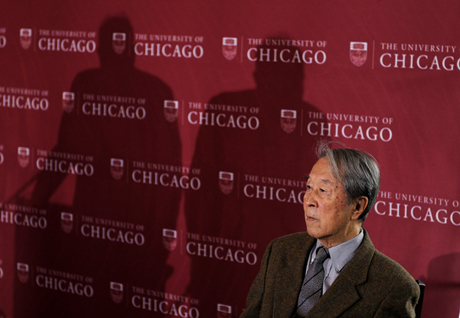| Sun | Mon | Tue | Wed | Thu | Fri | Sat |
|---|---|---|---|---|---|---|
| 1 | 2 | 3 | 4 | 5 | ||
| 6 | 7 | 8 | 9 | 10 | 11 | 12 |
| 13 | 14 | 15 | 16 | 17 | 18 | 19 |
| 20 | 21 | 22 | 23 | 24 | 25 | 26 |
| 27 | 28 | 29 | 30 | 31 |
CATEGORIES
RECENT ENTRIES
BLOG ROLL
Perfect symmetry
There’s a certain symmetry in the numbers: Tuesday the number of University of Chicago Nobel laureates rose to 82, the number in physics to 28.
Symmetry has long been a cornerstone of physics theory, as Yoichiro Nambu told an attentive audience yesterday morning, “but sometimes symmetry looks like it’s broken.” He offered a real-life example: “When you have a large crowd of people like here”—a Reynolds Club lounge filled with reporters, cameramen, colleagues, and well-wishers—“and they’re all facing toward me, not the other way around, there’s no physical reason they should all look the same way at the same time. That’s symmetry breaking.”
There was, of course, a reason to face toward Nambu, who shared the 2008 Nobel Prize in Physics with two Japanese researchers. Asked to explain “for a general audience” the concept of spontaneous symmetry breaking (SSB) that won him the prize, the 87-year-old Chicago professor emeritus offered this caveat: “It’s rather difficult because it’s a concept, not an application, something concrete.”
But, as 1980 Nobelist James Cronin, SM’53, PhD’55—an experimental physicist who has known Nambu since the Japanese-born theoretician came to campus in 1954—told the Reynolds Club crowd, SSB is a concept with solid applications “in superconductivity, in condensed matter, in magnetism.” He also emphasized the work’s larger meaning: “These basic ideas were really the foundation of beginning to understand the [Standard] model that works so beautifully in particle physics.”

It took several years of hard work to develop his theories, Nambu said, and reaction in the scientific community also took time. Cronin agreed: “It was not like a Eureka moment,” but “as experimental data came in and people tried to understand how it all fit together,” the work’s value became plain.
Nambu's Nobel, Cronin said, brought its own symmetry: “It's just a thrill from the bottom of my heart to see that the guy who started these ideas is recognized."
M.R.Y.
Photos by Dan Dry
October 8, 2008
